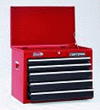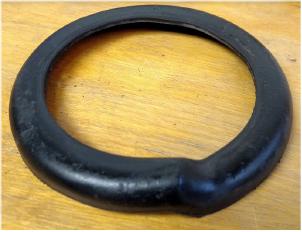

 EDITOR NOTE: This is a reprint of a series entitled Just the Tip authored by Thomas Brobst. His ‘make-do-with-what-you-got’ and ingenuity makes for interesting reading and maybe help a poor soul out of a perplexing repair. See if you agree with me this is fun reading.
EDITOR NOTE: This is a reprint of a series entitled Just the Tip authored by Thomas Brobst. His ‘make-do-with-what-you-got’ and ingenuity makes for interesting reading and maybe help a poor soul out of a perplexing repair. See if you agree with me this is fun reading.
Just the Tip
Tip #11
 ‘Allo, ‘allo, ‘allo, once again to my loyal readers ...haha. And Welcome to another
episode of tips for working in the garage and around the house. I’ve been busy, as I’m sure you
have been too, with driving you LBC, social activities, yard work and what-not. Sooooo, this
might be a short column since I’m writing it at the very last minute. ‘Allo, ‘allo, ‘allo, once again to my loyal readers ...haha. And Welcome to another
episode of tips for working in the garage and around the house. I’ve been busy, as I’m sure you
have been too, with driving you LBC, social activities, yard work and what-not. Sooooo, this
might be a short column since I’m writing it at the very last minute.
 This one might not apply to everyone. You’ll need a sand-blaster to take advantage of it.
That said, if you don’t have one yet, get one. They’re indispensable when it comes to restoration
work. That, and an air compressor, obviously. (I might talk about that in a later article). You don’t need to have a cabinet blaster. A
blasting gun and bucket of sand works fine for outdoor use. Those of you who live rurally can find some place in the back yar d
where a bit of sand on the grass won’t make any difference. City dwellers like me…..a cabinet works better. This one might not apply to everyone. You’ll need a sand-blaster to take advantage of it.
That said, if you don’t have one yet, get one. They’re indispensable when it comes to restoration
work. That, and an air compressor, obviously. (I might talk about that in a later article). You don’t need to have a cabinet blaster. A
blasting gun and bucket of sand works fine for outdoor use. Those of you who live rurally can find some place in the back yar d
where a bit of sand on the grass won’t make any difference. City dwellers like me…..a cabinet works better.
 Anyway, back to the issue at hand. What kind of parts do you usually sand blast? Metal of course, Duh!. But did you
know that rubber parts respond really well to sand blasting? I recently replaced the struts and shocks on my 1974 BMW 2002tii.
(Yes, I know, it’s not British …. but the point still applies as I used the same trick when I restored my MGA). The BMW has
MacPherson struts in the front so I was going to have to compress and remove the springs. Among the other necessary parts, I
ordered four new rubber spring seat pads, two for each spring, at $30 a pop! I mean, the car is 43 years old so I was sure th e pads
would need replacing. Anyway, back to the issue at hand. What kind of parts do you usually sand blast? Metal of course, Duh!. But did you
know that rubber parts respond really well to sand blasting? I recently replaced the struts and shocks on my 1974 BMW 2002tii.
(Yes, I know, it’s not British …. but the point still applies as I used the same trick when I restored my MGA). The BMW has
MacPherson struts in the front so I was going to have to compress and remove the springs. Among the other necessary parts, I
ordered four new rubber spring seat pads, two for each spring, at $30 a pop! I mean, the car is 43 years old so I was sure th e pads
would need replacing.
 I got everything apart. The strut housings were showing some rust holes in the lower spring seats so I sand-blasted them,
welded up the holes and powder coated them. The old rubber spring seat pads really looked bad. I mean, after all those years of
being squished by the spring into all that rust and road debris they were brown and pitted with rust and metal flakes. But before I
threw them in the trash and since I was already in sand-blast mode so I threw them in the blaster. Naught to lose, right? Wow! Did
they come out nice (nicely?). So nice, in fact, I reused three of them (one was too far gone). I got everything apart. The strut housings were showing some rust holes in the lower spring seats so I sand-blasted them,
welded up the holes and powder coated them. The old rubber spring seat pads really looked bad. I mean, after all those years of
being squished by the spring into all that rust and road debris they were brown and pitted with rust and metal flakes. But before I
threw them in the trash and since I was already in sand-blast mode so I threw them in the blaster. Naught to lose, right? Wow! Did
they come out nice (nicely?). So nice, in fact, I reused three of them (one was too far gone).

Before and after shot
|
:
|

After applying rubber dressing
|
 It seems that what happens is that the high velocity grains of sand just bounce off the rubber but not before removing anything that’s stuck to it such as rust, paint and dirt. After blasting I applied a rubber restorer and the rubber comes out black and looking like new! I understand that in the cemetery memorial industry they sand blast the text into the granite headstone usi ng a rubber template to protect the surface where they don’t want it etched. Makes sense. In the end I returned the three new, unused pads and got a $90 refund. Yeah, baby! It seems that what happens is that the high velocity grains of sand just bounce off the rubber but not before removing anything that’s stuck to it such as rust, paint and dirt. After blasting I applied a rubber restorer and the rubber comes out black and looking like new! I understand that in the cemetery memorial industry they sand blast the text into the granite headstone usi ng a rubber template to protect the surface where they don’t want it etched. Makes sense. In the end I returned the three new, unused pads and got a $90 refund. Yeah, baby!
Till next month, Cheery-oh!!
|